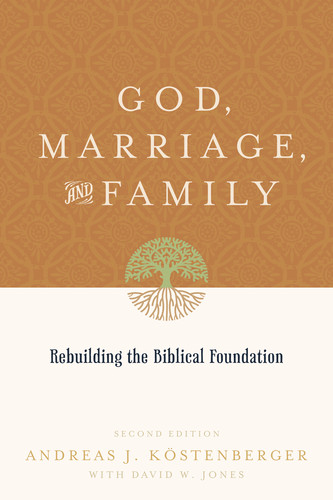Connecting Church and Family, Part 3

[Editor's Note: The following excerpt is part two in a series taken from chapter 13 of the recently released God, Marriage, and Family: Rebuilding the Biblical Foundation, Second Edition by Andreas Köstenberger with David W. Jones, © 2010 Crossway Books]
Click on the following links to read part one and part two in the series.
THE FAMILY-INTEGRATED CHURCH APPROACH
Having surveyed the basic biblical teaching on marriage and the family, having discussed the New Testament teaching on the church and its relationship with the natural family (along with their respective roles), and having suggested some ways in which the church can strengthen marriages and families, we turn to an evaluation of approaches that in recent years have sought to champion the cause of the family in the church. We do so with care, because, as will become clear, many of the concerns underlying these approaches are ones we share—in particular, a concern for the wellbeing and strengthening of the family. Ultimately, ecclesiology is the most poignant issue. Because these approaches are diverse and in many ways are still evolving, as will be seen in the discussion below, some important foundational doctrinal matters still are in need of further clarification.
Doubtless many are in churches with this philosophy of ministry because they care deeply for the family and are justly critical of traditional approaches to "doing church." A considerable number of these are homeschooling families who have a desire to duplicate the kind of close-knit family atmosphere in the church that they experience when educating their children at home. Some family-oriented churches appropriately adopt general principles such as multi-generational ministry, evangelizing entire households, encouraging fathers to be spiritual leaders in their homes, and so forth, without being philosophically and theologically committed to the more reactionary and at times even extreme core tenets of family integration. The critique of these approaches below applies to these groups only to the extent that they embrace the tenets of the movement on a more foundational theological and ecclesiological level.
While we share a deep conviction as to the importance of the family, we are committed to the biblical foundation for marriage and the family, and this includes a sound grasp of the New Testament teaching regarding the church. It is our tentative assessment that the family-integrated approach as defined below has elevated the family to an unduly high status that is unwarranted in light of the biblical teaching on the subject and that its view of the church as a "family of families" is not sufficiently supported by Scripture.17 We strongly urge the church to make families integral to the ministry of the church, supporting and strengthening them, but not in such a way that the New Testament teaching on the church is compromised or the family unduly elevated above the church.18
The beliefs and practices of a family-integrated church approach are not uniform.19 Some churches are more purist in their convictions and application of family integration, while others are amenable to combine this model with other approaches.20 The central plank in the family-integrated approach is usually the contention that families ought to worship together at church and stay together as they study the Scriptures, fellowship, and engage in other worship-related activities.21 The heads of households (the fathers) are enjoined to be spiritual leaders in the home and the church, which has important implications for the way in which the church engages in ministry. Rather than hiring a youth pastor, for instance, a church may pursue a form of family-based youth ministry in which the parents of youth join together ministering to their young people, perhaps with one or several such men coordinating these efforts or not having a youth ministry per se at all.
In order to understand the driving motivation behind the family-integrated church approach, it is critical to grasp that this approach sets itself in opposition to the conventional way of "doing church" today. According to those who advocate family integration, the traditional approach illegitimately separates people at church into age and other affinity groups such as singles, young marrieds, youth, seniors, and so on. What those favoring a family-integrated approach contend is that this "segregation" (an often-used, though less-than-ideal term; see below) divides families rather than strengthening them and bringing them closer together. Instead, churches should integrate rather than segregate families and orient their ministry to the unit of the natural household, with the father as the head. In this regard, the argument is often made that a family-integrated approach better represents the practice of the early church and is more in keeping with Puritan ecclesiology.22
The realization of the church's need to strengthen rather than weaken family units has often been precipitated by husbands' realizing their failure to make their marriages and families a sufficient priority. Voddie Baucham Jr., for example, in his book Family Driven Faith, spent the majority of his book sharing his testimony in this regard and urged fathers and husbands to put a priority on these roles, with one or two concluding chapters being devoted to discussing implications for the church.23 In other noteworthy contributions, Mark Fox chronicled his own journey toward a family-integrated church, and Eric Wallace called for a "uniting" of church and home.24 All these efforts center on restoring the father's rightful place as the spiritual leader in his home and on building the church on the foundation of these households of faith. As such, they provide a positive stimulus to the church in bringing it back to God's plan for the family.
As was alluded to above, however, the general lack of a thorough biblical rationale for a family-integrated approach makes it somewhat difficult to evaluate. At times, a case is made more along general historical or practical lines. At other times, the argument proceeds from what a "family-integrated" approach is not—segregating church members by age group and life status, etc.—that is, arguments are framed in light of the perceived failures of the traditional church. Where Scripture is cited, reference is most commonly made to the Old Testament, or scriptural passages are cited that are very general in scope and do not necessarily support a family-integrated church approach as such.
CONTRIBUTIONS AND POSSIBLE LIMITATIONS OF A FAMILY-INTEGRATED APPROACH
A family-integrated church approach has the potential of making several important contributions to a church that in many ways reflects the surrounding culture in its fractured relationships, a church that frequently falls short in reinvigorating families as cells where the faith of its members is nurtured. Three such contributions, in particular, may be noted here. First, this approach promises to provide a more holistic way of engaging in ministry, reaching out to entire households as Paul and the early Christians did rather than viewing people solely on an individualistic basis. Also salutary is the emphasis on the role and spiritual responsibility of the father. It is true that many pastors in traditional churches have failed to encourage and nurture the father in his role as the spiritual leader in his home. In how many churches, for example, is specific instruction and support provided for fathers on how to conduct family worship? This indeed seems to be an area to which insufficient attention has been given in many churches, and the family-integrated church approach can serve as a vital corrective. Third, strong families are the backbone of a healthy church, whether traditional or family-integrated, so that even churches that are reluctant to embrace family integration in their entirety as a guiding philosophy may want to incorporate some of its helpful features.
Several notes of caution may be registered as well. To begin with, in light of the racial overtones of the term "segregation," such language is best avoided when speaking of traditional church practice. Assuming an antagonistic stance likely lessens consideration of valid insights by those advocating a family-integrated approach on the part of traditional churches. In this regard, it will be helpful to avoid an "us against them" mentality and not to operate in a reactionary mode in this discussion. The true enemy is not the traditional church—it is Satan —and the church's central message is not family integration but the gospel of salvation by grace and through faith in the Lord Jesus Christ. Also, it will be important to avoid possible sectarianism and for all sides to be humble and open rather than closed and resistant to valid critiques offered in a spirit of love.
As already stated, it is essential not to elevate marriage and family above the church. Viewed from an end-time perspective, earthly marriage and family life are but "training wheels" of sorts, designed to prepare one for an eternal relationship (or marriage) to Christ. After all, there will be no human marriage on the "new earth"—the institution of family will have served its purpose. Seen in light of eternity, therefore, marriage and family have an important preparatory function but ought not to be absolutized or placed above God's eternal kingdom purposes. In the same vein, there is no biblical justification for considering the authority of the paternal head of the household as overriding, or even equal to, that of the local church leadership.25
Another concern relates to the very notion of integration itself. A New Testament church should be integrated in every conceivable manner, not only with regard to family but also with regard to gender, age, race, color, socioeconomic status, and so on. In order to reflect the identity of its Creator, who made all of his creatures, and of its Redeemer, who saved all kinds of people, the church ought to be all-inclusive and embracing. For this reason any approach or group that focuses on one kind of integration while not equally emphasizing integration in every other conceivable dimension falls short of the biblical ideal of God's kingdom. The family-integrated church approach can actually tend to promote a lack of general integration as these churches may at times neglect to include those from broken families. In fact, some churches may ironically foster the very segregation that they are trying to correct, albeit a segregation of intact families from those with less-than-ideal family backgrounds.26
As far as keeping families together at church, there seems to be no good reason why families could not engage in family worship at home while worshiping with other believers, including in peer and other groupings, at church. Nowhere in Scripture is it taught that families must cluster together at all times when the church is gathered. Just as fathers may lead their family in worship and Bible reading at home, so the pastor of a local church may lead the entire congregation made up of people from a variety of familial and social backgrounds, in joint worship. The same can be said about a variety of other forums and settings—such as Sunday School, children's worship, or youth group—which the church may choose to institute in order to fulfill its scriptural mandate to instruct and edify believers.
The question also remains as to whether a family-integrated approach is primarily founded on biblical and theological premises or is posited based on method or preference. If the former, this would mean that any other approaches fall short of what Scripture commands. If the latter, this would call for openness to a variety of methods, none of which can claim to be the only biblical approach. This would also allow for a blending of these elements, such as incorporating a more overt family orientation in traditional churches and balancing those with extreme family integration.27 Another question that arises is to what extent the family-integrated approach is predicated upon a theology that stresses the continuity between Old Testament Israel and the New Testament church and neglects to give proper recognition to the pronounced New Testament emphasis on individual faith.
Finally, the emphasis on male headship may at times tend to diminish women's significance and role. In an effort to strengthen men as leaders, women may at times not be adequately affirmed in the great variety of contributions they can make to the home, the church, and society. In some cases, a form of male patriarchy may take on a type of authoritarianism that proves excessive.
CONCLUSION
A study of Jesus' teaching on the subject indicates that he emphasized the reality that often the father or other members of a given family will not become believers and that all those who do will constitute a new, spiritual family, being related to one another as brothers and sisters in Christ. Thus, dependence on an unbeliever as a spiritual head would be untenable. Instead, the body of Christ becomes the family to those who are in this situation. Paul also speaks of the church as an entity in its own right without reference to the family as part of its structure. Officers such as elders and deacons and pastor-teachers oversee the church as "shepherds" of the "flock" (Acts 20:17-35; 1 Tim. 3:1-15; Titus 1:6-9; see also 1 Pet. 5:1-3). While Old Testament Israel was a theocracy and based on clan and tribal kinship ties, Jesus said that anyone who did the will of his Father was his brother and sister. Certain limitations of the household model for the church apply, and doubt is cast on a straightforward transposition of the Old Testament patriarchal model onto the New Testament church.
Turning to the Epistles, it is apparent that church membership is not a matter of belonging to a covenant family where one or both of the parents are believers. Instead, as mentioned, the New Testament criterion for church membership is that of personal repentance and faith in the Lord Jesus Christ. The primary basis and constitutive principle of New Testament ecclesiology, therefore, is not that of ethnic or household membership but of individual faith in Jesus Christ. It follows that the church is made up of all regenerate, born-again believers in Christ, who now constitute the spiritual family and household of God.28 Even in cases where this includes entire households, the fact remains that those related to one another by natural relations are brothers and sisters in Christ first and related by way of flesh-and-blood ties second.29
Believers, therefore, are called to love and care for each other as natural brothers and sisters would. Thus they act toward non-flesh-and-blood relatives as if they were related, because they are spiritually—they are united in their common faith in Jesus Christ. What is more, even in families where every member is a believer in Christ, it is not primarily their natural kinship that unites them but their faith. Because of that shared faith, they worship together, minister together, pray together, and study the Scriptures together. In this new family, in a miraculous way, they love total strangers as if they were their fathers and mothers and sisters and brothers because, in Christ, they are. As a result, they have more in common with them than they do with their natural relatives who do not share the same faith.
So those who have never been married, those who are widowed or divorced, those who are young or old or rich or poor—all belong and fit together in the church. It is not just natural family units that are being re-empowered. The New Testament concept of the church as the family of God transcends flesh-and-blood ties. At the same time, it is appropriate to call on wholesome and godly families in the church to band together to set the example of what a Christian family should look like and to draw in those who come from broken backgrounds and to integrate them into the church family.
This is a crucial component: that a truly integrated church will not discriminate against those who are not currently in fully intact families or against those who have the spiritual gift of singleness, but will genuinely be open to welcome them into its midst. Those called to singleness, for example, should be viewed as "kingdom units" on par with families rather than the latter asserting superiority over the former. A truly integrated church should reflect the full diversity of the body of Christ that will characterize the kingdom of heaven in its eternal state (see the book of Revelation) and genuinely reach out to everyone in the community rather than possibly being exclusive and privileging intact father-mother-children households over others.
Jesus' example is particularly instructive here, as our Lord walked a very fine line. On the one hand, he affirmed the natural family (Matt. 19:4-6 and pars.). On the other hand, he preached the coming kingdom of God with its spiritual kinship of faith transcending natural relations. Thus the demographic profile of the church should not merely reflect father-led natural households. In the end, any individual who is doing the will of God is a rightful member of God's kingdom. Paul, likewise, hinted at this when he wrote, "From now on, let those who have wives live as though they had none. . . . For the present form of this world is passing away" (1 Cor. 7:29, 31), while affirming natural marriage and family as the norm in this life (Eph. 5:21-6:4).
For these and other reasons the church should be family-oriented and family-friendly. The leaders of the church should themselves model healthy family relationships (1 Tim. 3:4-5) and seek to equip the families in the church to be worshiping communities, embodying on the microlevel what the church ought to reflect on the macro-level as the "household of God" (1 Tim. 3:15). This requires churches to be more intentional in their approach to mentoring and discipleship. It calls them to focus their efforts more overtly on equipping men to practice their Christian faith in their homes as spiritual leaders of worship, Scripture reading, etc., rather than conceiving of mentoring and discipleship primarily or exclusively on an individual level.
Also, it is important that this be done on a church-wide basis rather than merely by way of special, optional programs such as marriage seminars or discipleship classes on marriage and the family. Every aspect of the church should be oriented toward people in their family context and include those from broken or unusual situations. With godly families as the backbone of the congregation, those who are currently (or permanently) unmarried can be drawn into a family environment that makes for healing for those recovering from broken relationships and hope for those longing for loving, nurturing family relationships in the future, whether young and unmarried or previously married.
What, then, is the proper way to conceive of the relationship between the family and the church? Are they to be pitted against one another as if the church needs to be kept at bay so families can disciple their children without undue interference from the church? Is the church to be elevated to the extent that families are submerged under a flood of programs and suffer as a result? Neither extreme is desirable. Instead, the church and the family each ought to recognize their God-given roles and to partner together in bringing glory to God and to respect and affirm each other's respective spheres. Whose role, for example, is it to nurture marriages and to disciple children? In one sense, the marriage partners themselves ought to work on their marriage and parents should accept their God-given mandate to bring up their children in the nurture and admonition of the Lord (Eph. 6:4). At the same time, it is certainly also the role and responsibility of the church to nurture marriages, to strengthen families, and to evangelize and disciple—the church as led by mature, biblically qualified and duly appointed men (elders) and consisting of regenerate, born-again, and Spirit-indwelt and equipped believers in the Lord Jesus Christ. If the church does not lord it over its members—whether single or married—and the family humbly accepts its limitations in God's plan—a harmonious, spiritually fruitful, God-glorifying partnership can develop in which all of the church's members are submitted to the church's leaders and all are ultimately submitted to Christ as the church's head (Eph. 1:10; 4:15-16; 5:23-24; 1 Pet. 5:5-6).
Thus Paul's vision will increasingly become a reality, according to which God "gave the apostles, the prophets, the evangelists, the shepherds and teachers, to equip the saints for the work of ministry, for building up the body of Christ, until we all attain to the unity of the faith and of the knowledge of the Son of God, to mature manhood, to the measure of the stature of the fullness of Christ, so that we may no longer be children, tossed to and fro by the waves and carried about by every wind of doctrine . . . Rather, speaking the truth in love, we are to grow up in every way into him who is the head, into Christ, from whom the whole body, joined and held together by every joint with which it is equipped, when each part is working properly, makes the body grow so that it builds itself up in love" (Eph. 4:11-16). These individual parts and joints, it is important to remember, are individual believers, not necessarily family units, as Jesus made clear when he predicted that the truth of the gospel would divide households (Matt. 10:36; cf. Mic. 7:6) so that the new, spiritual family of God, the church, would not correspond to clusters of individual families.
We conclude with a few questions that all churches, whether family-integrated or not, should ask: (1) Do we acknowledge singleness as a valid spiritual gift and singles as church members and citizens of the kingdom on par with families, or do we privilege families and treat singles as somehow deficient and second-class? (2) Do we reach out to everyone regardless of their stage of life, race, and class, or only to certain people in keeping with the demographic makeup of the majority of church members, be it those of a certain socioeconomic profile, or homeschooling families, or any other grouping? In other words, is our church genuinely inclusive in keeping with Jesus' proclamation of the kingdom of God? (3) Do we understand and practice Jesus' teaching about the kingdom and the New Testament teaching about the church? Or is our model predominantly or exclusively predicated upon Old Testament models?
Certainly, the current debate over how the family and the church relate is very much ongoing. As the discussion progresses, the terminology will undoubtedly change, new models will be set forth, and the debate will hopefully become less reactionary. In the end, it is important to remember that the solution lies ultimately not in any one given approach or set of labels. The abiding questions continue to center on the importance of the family, on what the Bible teaches about the nature of the church, and on the way in which the church can best carry out its divine mandate— including strengthening and supporting families—in order to fulfill the Great Commission to disciple the nations.
Click on the following links to read part one and part two in the series.
[Editor's Note: Taken from chapter 13 of the recently released God, Marriage, and Family: Rebuilding the Biblical Foundation, Second Edition by Andreas Köstenberger with David W. Jones, © 2010 Crossway Books]
Andreas J. Köstenberger is director of PhD Studies and professor of New Testament at Southeastern Baptist Theological Seminary in Wake Forest, North Carolina. He is a prolific author, distinguished evangelical scholar, and Editor of the Journal of the Evangelical Theological Society. Dr. Köstenberger and his wife have four children.
David W. Jones is Assistant Professor of Christian Ethics at Southeastern Baptist Theological Seminary. Dr. Jones is married with two children.
ENDNOTES:
17. See especially the critiques by R. Albert Mohler, posted online at www.albertmohler.com and Webb, "Family-Integrated Church Movement."18. Space constraints do not permit a full critique; but see Webb, "Family-Integrated Church Movement."
19. Webb, "What is the Family-Integrated Church Movement? (Part 1)," notes that on the basis of the "family of families" model, the family-integrated church movement generally embraces the following three principles: (1) families worship together; (2) evangelism and discipleship are done through homes; and (3) an emphasis on education (homeschooling) as a key component of discipleship.
20. See esp. Timothy Paul Jones, ed., Perspectives on Family Ministry (Nashville: B&H Academic, 2009), which presents three major models of family ministry: family-integrated, family-based, and family-equipping (see the summaries on pp. 42-45 and the comparison chart on p. 52). However, of these only "family-integrated" is widely used at the time of writing, which is why we will use this terminology in the remainder of this chapter, especially since all three models share considerable common ground (such as the primary role of fathers and parents in the spiritual development of their children and the importance of multigenerational ministry; see ibid., pp. 46-48) and differ primarily in the degree to which they are willing to work within existing church structures: the family-integrated model eliminates all age-graded events; the family-based approach leaves most of the essential church structure intact and seeks to transform it from within and make it more family-oriented; and the family-equipping model calls for a complete restructuring of the church while keeping family and church distinct as partners in promoting biblical family roles.
21. At times, the "regulative principle" (the belief that the church should do only what is explicitly commanded in Scripture) is invoked in support for eschewing youth groups or nurseries by proponents of the "family-integrated church movement," often citing Mark Dever, The Deliberate Church: Building Your Ministry on the Gospel (Wheaton, IL: Crossway, 2005), chaps. 6-7. But see the critique in Jones, Perspectives, 134-35, where Brandon Shields deplores an "oversimplified dichotomy between ‘biblical' and ‘unbiblical'" by "those who hold to extreme perspectives on the regulative principle," citing Edmund P. Clowney, The Church: Contours of Christian Theology (Downers Grove, IL: InterVarsity, 1995), 126.
22. Space constraints do not permit a detailed discussion of the matter. For a persuasive refutation of this claim see Webb, "What Is the Family-Integrated Church Movement? (Part 4)," who discusses especially Richard Baxter (who was single) and John Owen.
23. Voddie Baucham Jr., Family Driven Faith: Doing What It Takes to Raise Sons and Daughters Who Walk with God (Wheaton, IL: Crossway, 2007).
24. J. Mark Fox, Family-Integrated Church: Healthy Families, Healthy Church (Longwood, FL: Xulon, 2006); Wallace, Uniting Church and Home.
25. Indeed, it is highly precarious to submerge the local church and its leadership under the aegis of an aggregate of father-led families to the point that the two become all but indistinguishable.
26. A point made by Brandon Shields in Jones, Perspectives, 138-39, who calls for "common- sense realism": "viewing the world as it is," by which he means taking "people and culture as they are before attempting to impose our idealistic visions on them." See also the response by Paul Renfro in ibid., 171-72, under the heading Incrementalism versus Family Integration.
27. See the above-mentioned three models presented in Jones, Perspectives on Family Ministry.
28. Webb, "What Is the Family-Integrated Church Movement? (Part 2)," especially 2: The New Covenant People are Regenerate and 7: The Members Are in the Covenant as Individuals.
29. In personal conversation on November 19, 2009, R. Albert Mohler pointed out to me (Andreas Köstenberger) that failing to draw a clear line between regenerate and unregenerate family members also creates a problem by allowing unregenerate children of believing parents to participate in Communion. See also Webb, "What Is the Family-Integrated Church Movement? (Part 5)," who raises several important theological matters of needed clarification, including the following:
(1) What do proponents of the "family-integrated church movement" mean when they say that families are the building blocks of churches? Do they acknowledge that individual faith and regeneration are what gets a person into the church?
(2) Do people stay in the new covenant by keeping the covenant? Do children need to learn to obey to stay in covenant with God? Or are we kept in the new covenant by God's grace, who supplied us at conversion with a new heart that allows us to be faithful? What of the need for repentance and a new spiritual birth?

Originally published July 08, 2010.








